
by Larry Williams | Jan 14, 2019
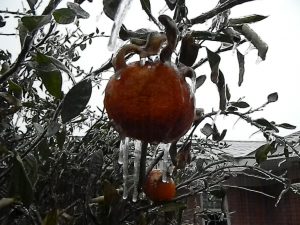
Ice on Satsuma fruit from January 2014 ice storm in Crestview, FL. Photo credit: Larry Williams
Northwest Florida winters can be a rollercoaster ride of temperatures. One week it dips to freezing for a short time and the next week it rises to spring-like temperatures. We need to hold on for this ride of up and down temperatures but not over react too soon.
Following the sudden ride down to the lower temperatures, we may think winter is over. But we don’t see the next drop in temperatures that’s coming, as we are experiencing the ride upwards in temperatures.
On average, it’s not until we reach mid-March that we expect our last killing frost. A killing frost is heavy enough to kill tender plant growth. And, we can have light frosts well into the latter part of March and into early April. This is particularly true in the more northern portions of our Panhandle Counties.
The main point is to not get spring fever too early and encourage new plant growth by pruning or fertilizing too soon.
When landscape plants freeze, the first impulse may be to get out the pruning shears and cut away dead and dying leaves and branches. But this isn’t a good idea. Pruning can force new tender growth that is more likely to be injured by the next freeze. And, you can’t tell how much damage has been done until plants start new growth in spring. If you prune immediately after a freeze, you may cut away live wood that doesn’t have to be lost. Also, leaves and branches, which have been killed, can help protect the rest of a plant
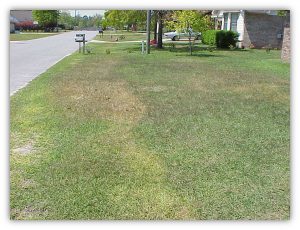
Cold injury to lawn that happened March 31 in Crestview, FL. Photo credit: Larry Williams
against further cold injury.
Some people want to “jump start” their lawns before our weather will allow our grasses to grow. Waiting allows for more efficient use of the lawn fertilizer. You will not injury your lawn by
waiting but you can certainly injure your lawn by fertilizing too early.
So, have patience, allow your lawn to green up on its own and then fertilize, even if it’s not until April or May.
Finally, be a little philosophical. If you do lose one or two of your tender ornamentals, so what? Worse things could happen. And now you have a chance to add something new, perhaps some species native to our area that are not as subject to cold damage.
Even with this winter/spring rollercoaster ride, with thousands of plants to choose from and a generally mild climate, who can complain?
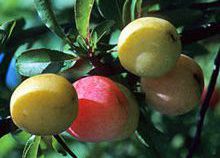
by Carrie Stevenson | Jan 7, 2019

The Chickasaw plum is covered in beautiful small white flowers in the spring. Photo credit: UF IFAS
The native Chickasaw plum is a beautiful smaller tree (12-20 ft mature height) that is perfect for front yards, small areas, and streetscapes. True to its name, the Chickasaw plum was historically an important food source to Native American tribes in the southeast, who cultivated the trees in settlements well before the arrival of Europeans. They typically harvested and then dried the fruit to preserve it. Botanist-explorer William Bartram noted the species during his travels through the southeast in the 1700’s. He rarely saw it in the forests, and hypothesized that it was brought over from west of the Mississippi River.
One of the first trees to bloom each spring, the Chickasaw plum’s white, fragrant flowers and delicious red fruit make it charmingly aesthetic and appealing to humans and wildlife alike. The plums taste great eaten fresh from the tree but can be processed into jelly or wine. Chickasaw plums serve as host plants for the red-spotted purple butterfly, and their fruit make them popular with other wildlife. These trees are fast growers and typically multi-trunked.
Almost any landscape works for the Chickasaw plum, as it can grow in full sun, partial sun, or partial shade, and tolerates a wide variety of soil types. The species is very drought tolerant and performs well in sandy soils.
The plum is in the rose family and has thorns, so it is wise to be aware of these if young children might play near the tree.
Winter is ideal tree-planting time in Florida. While national Arbor Day is in spring, Florida’s Arbor Day is the 3rd Friday of January due to our milder winters. This year, Escambia County’s tree giveaway will include Chickasaw plums, so if this tree sounds like a great addition to your landscape, come visit us on January 19 and pick one up.
For more information about tree selection in northwest Florida, contact your local county Extension office.
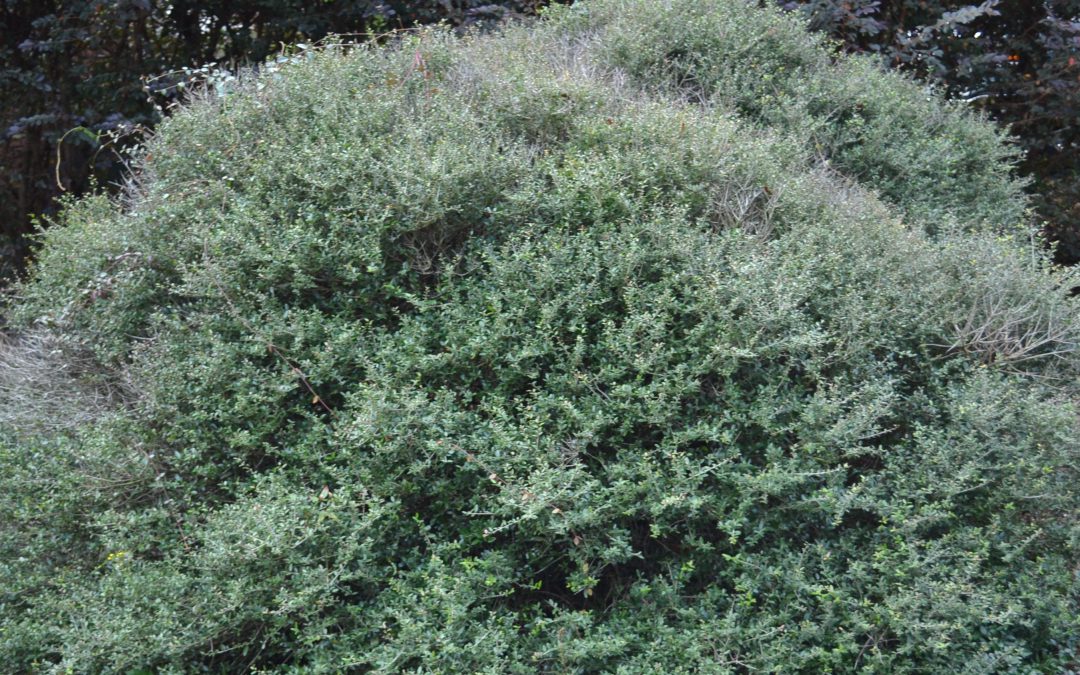
by Beth Bolles | Jan 3, 2019
Shrubs can serve many purposes in a landscape and have been used in both mass plantings and as accent features. They can include plants that offer colorful blooms, food for pollinators, and screens for less than favorable views.
We tend to think that shrubs will be permanent feature in our landscapes, because many are hardy and adapted to our climate. Like any other plant you may choose for your yard, shrubs may not live forever and there are a wide variety of reasons a shrub may need replacement after years of solid performance.
Let’s use any example from my own yard of the Dwarf yaupon holly, Ilex vomitoria ‘Nana.’ Back in 2001, I planted three hollies, spaced with plenty of room to grow, in a border area of my landscape. The plants grew well forming mounds about 3.5 feet high and 4 feet wide. Since the ‘Nana’ holly is a naturally mounding shrub, it did not require pruning and once established, rainfall supplied needed water.
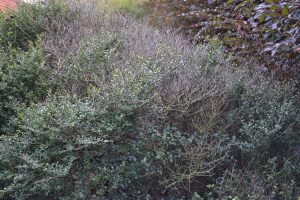
Yaupon holly with dieback after 17 years in a landscape. Photo by Beth Bolles, UF IFAS Extension Escambia County
Over the past year, several areas of branch dieback have developed in all plants. After finally deciding that the dieback was unattractive enough to warrant plant removal, I began cutting the plants back. I discovered dead interior branches, girdling roots, and some internal stem discoloration. In other words, there are many factors that have led to poor plant performance. Another issue is a large Loropetalum hedge (planted by my neighbor) that shades one side of the plant.
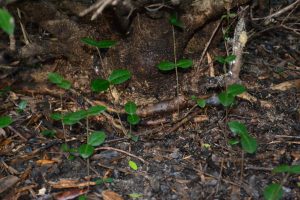
Girdling roots often develop when rootballs have not been properly prepared during installation. Photo by Beth Bolles, UF IFAS Extension Escambia County
What could I have done to help these plants stay healthier for many more years? I could have prepared the rootball better for planting by shaving off the edges or supplied a little fertilizer on occasion in my sandy soil. These practices may have extended the life of the plants for several more years, but they may not have made a difference. Sometimes shrubs decline and die. I am accepting that not everything performs at an outstanding level in our climate. Also, there is an end point for some of my favorite plants in the yard. Some may outlive me while others thrive for a few years or a decade or so.
The bright side of loss of my Yaupon hollies is that I get to plan for a feature for the new year. Maybe something for pollinators and birds to last the next 17 years.
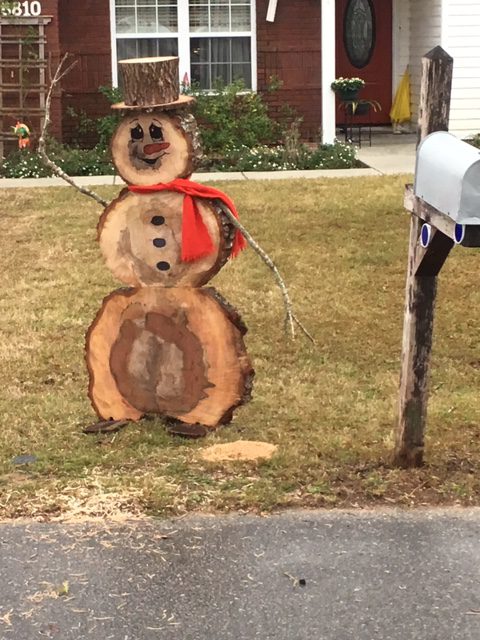
by Julie McConnell | Jan 3, 2019

Storm debris turned into holiday cheer in Bayou George. Photo: J_McConnell, UF/IFAS
By the time this article publishes, we will be more than 70 days since Hurricane Michael toppled or damaged an incredible number of trees in the Panhandle. Enormous piles of once stately shade trees line the streets in neighborhoods and business districts in. The cleanup efforts have been phenomenal, over 4 million cubic yards of storm debris picked up in Bay County to date, but there is still a long way to go in the recovery process.
So, as gardeners, how can you help our community get back on track amidst your own struggles to recover? A few Florida Friendly Landscaping™ Principles come to mind.
- #1 Right Plant, Right Place – as you rebuild your landscapes, make sure to choose the appropriate plant for the location. Consider mature size and give those plants space to thrive!
- #4 Mulch – do you have bare ground that will eventually become landscape beds or turf but no resources or time to replant yet? Consider mulching the area to keep soil from eroding and to help improve soil though decomposition of natural products. Hint – see Recycling for free sources!
- Mulch tips https://sfyl.ifas.ufl.edu/media/MulchBrochure.pdf
- keep mulch 12 inches from tree trunks
- recommended depth in beds or under dripline of tree canopy (excluding within 12” of trunk) is 2-3 inches
- leave an 18-24 inch buffer around building foundations mulch free to reduce conducive termite conditions
-
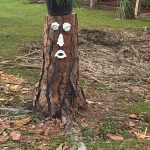
Dress up stumps with plants and whimsical designs. Photo: D_VanderMeer, UF/IFAS Master Gardener
#7 Recycle – driving around town I have seen some really creative uses for stumps, trunks, and branches that homeowners have constructed and messages of hope that bring a smile to my face. Another method of recycling is to use the chipped vegetative debris as mulch, either available as “utility mulch” by cities and counties or you may have some in your own yard right now.
- Utility mulch does come with some words of caution because there is an increased risk of introducing weeds to your landscape with untreated storm debris. However, if you need mulch for pathways or planting beds you will be helping your community’s cleanup effort by reducing waste accumulation. Just watch for “volunteer” plants and manage as needed.
In Bay County, there are 4 locations where you can load and haul off your own utility mulch from storm debris
- Under the Oaks Park – 5843 E. U.S. 98, Panama City, FL 32404
- G. Harder’s Park – 8110 John Pitts Rd., Panama City, FL 32401
- Chapman Park – 2526 Rollins Ave., Bayou George, FL 32404
- Laird Park – 6310 Laird Park Rd., Panama City, FL 3240
For sources in your county, check with your Solid Waste Department for utility mulch availability.

by Mark Tancig | Dec 17, 2018

Native trees, like this Live Oak (Quercus virginiana), provide habitat for various insects fed upon by birds. Source: James Holland, Bugwood.org
Planting native plants is a topic many north Florida gardeners, and subscribers to Gardening in the Panhandle, have seen covered in various ways and formats. It doesn’t take a great leap of understanding to realize that native plants are highly valued by our wildlife, which have adapted to living with these plants for millennia. However, we also get a lot of information about the latest, greatest landscape plant variety, many of which are non-native, and are lured to purchase them by their beautiful flowers and/or foliage. In the wake of Hurricane Michael, the importance of selecting native plants for the landscape becomes apparent when you look around and see whole forests severely disturbed. Furthermore, recent research has shown how much our native wildlife prefer native plants and need them for the best chances of survival.

Eastern bluebirds are an example of a bird that relies on insects. Source: Sandysphotos, Creative Commons.
Why Native Plants?
It’s not that non-native ornamental plants are “bad”, unless they’re the terrible invasive, exotic species like kudzu, Chine privet, etc., it’s just that the food chains that support our wildlife are adapted to native plants. A recent report published in the National Proceedings of Science found that chickadees had far better success fledging young when they foraged landscape areas containing 70% or more native plant cover. The reason for their success was that the insects they feed on utilize native species more than non-native plant species. Does that mean non-natives provide no value? Not necessarily. Non-native ornamental plants can be important sources of nectar and pollen and, as you know from experience dealing with pest problems on non-native plants, they also support insects. Native plants just support more of an abundance of these insects.
Following a large disturbance like Hurricane Michael, many insects, birds, and other wildlife will likely see a decrease in numbers and/or reproductive success due to the loss and/or disruption of native plant ecosystems. As stated in the recent report, restoration of urban areas should prioritize native plants to support local food webs.
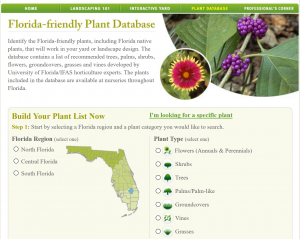
The deactivated_site website is a great resource to find native trees for your area. Source: Screenshot, deactivated_site.
The deactivated_site website is an easy way to start putting together a list of potential plants. The website’s Florida-Friendly Plant Database allows users to select the area of Florida they live in, site conditions, plant type (tree, shrub, etc.), and to specify native plants only. It then searches the database for plants that meet those conditions and creates a list of species, along with photos and care information. If you’re thinking about how these trees hold up to storms, you can cross-check that list with UF/IFAS’s Wind and Trees EDIS publication. Of course, if you have any questions along the way, please contact your local UF/IFAS Extension Office.
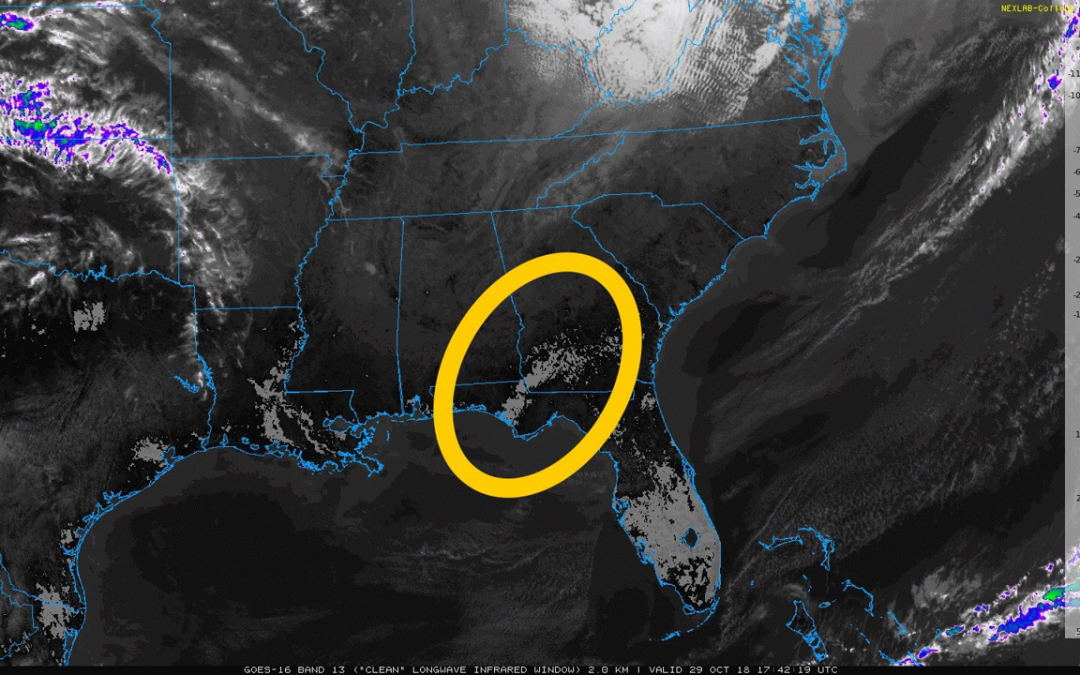
by Daniel J. Leonard | Nov 21, 2018
After a devastating windstorm, as we just experienced in the Panhandle with Hurricane Michael, people have a tendency to become unenamored with landscape trees. It is easy to see why when homes are halved by massive, broken pine trees; pecan trunks have split and splayed, covering entire lawns; wide-spreading elms were entirely uprooted, leaving a crater in the yard. However, in these times, I would caution you not to rush to judgement, cut and remove all trees from your landscape. On the contrary, I’d encourage you, once the cleanup is over and damaged trees rehabilitated or disposed of, to get out and replant your landscape with quality, wind-resistant trees.
First, it’s helpful to take a step back and remember why we plant and enjoy trees and the important role they play in our lives. Beyond the commercial aspect of farmed timber, there are many reasons to be judicious with the chainsaw in the landscape and to plant anew where seemingly sturdy trees once stood. For example, trees provide enormous service to homes and landscapes, from massive cooling effects to aesthetic appeal. Take this thermal satellite image of Hurricane Michael’s path that simultaneously shows the devastation of a major hurricane and the role trees play in the environment.
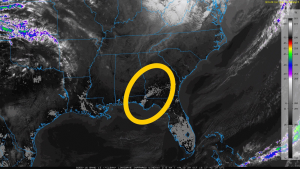
Lightly shaded area showing higher ground temperatures from loss of vegetation.
In the lighter colored areas where the wind was strongest and catastrophic tree damage occurred, the ground temperatures are much higher than the unaffected areas. Lack of plant life is entirely to blame. Plants, especially trees, provide enormous shading effects on the ground that moderate ground temperatures and the process of transpiration releases water vapor, cooling the ambient air. Trees also lend natural beauty to neighborhood settings. There is a reason people termed the hardest hit areas by Michael “hellscapes”, “warzones”, etc. Those descriptions imply a lack of vegetation due to harsh conditions. In this respect, trees soften the landscape with their foliage colors and textures, create architecture with their height and shape, and screen people from noise, unpleasant sights and harsh heat.
Though all trees give us the benefits outlined above, research conducted by the University of Florida over a span of ten major hurricanes, from Andrew to Katrina, shows that some trees are far more resistant to wind than others and fare much better in hurricanes. In North Florida, the trees that most consistently survived hurricanes with the least amount of structural damage were Live Oaks, Cypresses, Crape Myrtle, American Holly, Southern Magnolia, Red Maple, Black Gum, Sycamore, Cabbage Palm and a smattering of small landscape trees like Dogwood, Fringe Tree, Persimmons, and Vitex. If one thinks about these trees’ growth habits, broad resistance to disease/decay, and native range, that they are storm survivors comes as no surprise. Consider Live Oak. This species originated along the coastal plain of the Southeastern United States and have endured hurricanes here for several millennia. Possessing unusually strong wood, they have also developed the ability to shed the majority of their leaves at the onset of storms. This defense mechanism leaves a bare appearance in the aftermath but allows the tree to mostly avoid the “umbrella” effect other wide crowned trees experience during storms and retain the ability to bounce back quickly. Consider another resistant species, Bald Cypress. In addition to having a strong, straight trunk and dense root system, the leaves of Bald Cypress are fine and featherlike. This leaf structure prevents wind from catching in the crown. Each of the other listed species possess similar unique features that allow them to survive hurricanes and recover much more quickly than other, less adapted species.

Laurel Oak split from weak branching structure.
However, many widely grown native trees and exotic species simply do not hold up well in tropical cyclones and other wind events. Pine species, despite being native to the Coastal South, are very susceptible to storm damage. The combination of high winds and beating rains loosens the soil around roots, adds tremendous water weight to the crown high off the ground, and puts the long, slender trunks under immense pressure. That combination proves deadly during a major hurricane as trees either uproot or break at weak points along the trunk. In addition to pines, other widely grown native species (such as Pecan, Laurel Oak and Water Oak) and exotic species (such as Chinese Elm) perform poorly in storms. Just as the trees that survive storms well possess similar features, so do these poor performers. We’ve already mentioned why pines and hurricanes don’t mix well. Pecan, Laurel Oak, and Water Oak tend to have weak branch angles and break up structurally in wind events. The broad spreading, heavy canopy of trees like Chinese Elm cause them to uproot and topple over. It would be advisable when replanting the landscape, to steer clear of these species or at least site them a good distance from important structures.
This piece is not a warning to condemn planting trees in the landscape; rather it is a template to guide you when selecting trees to replant. Many of our deepest memories involve trees, whether you first climbed one in your grandparent’s yard, fished under one around a farm pond, or carved your initials into one in the forest. Don’t become frustrated after a once in a lifetime storm and refuse to replant your landscape or your forest and deprive your children of those experiences. As sage investor Warren Buffett once wisely said, “Someone is sitting in the shade today because someone planted a tree a long time ago.”
For these and other recommendations about how to “hurricane-proof” your landscape, contact your local UF/IFAS Extension Office. Plant a tree today.

















